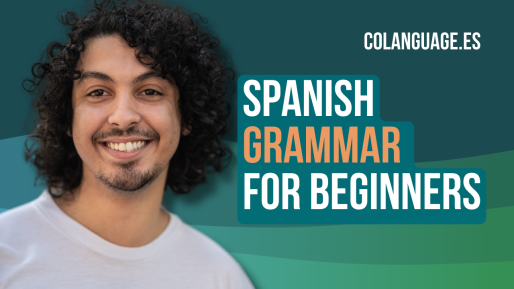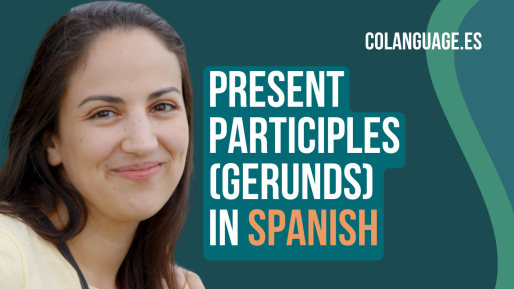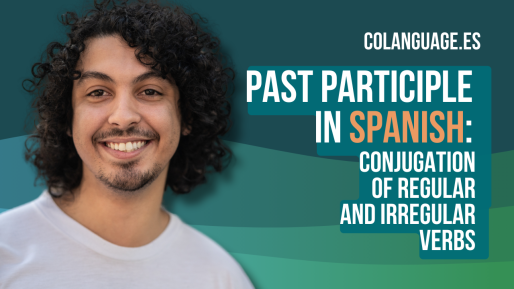Past and present continuous (estar + gerund) of regular verbs in Spanish Share Copied!
Spanish
Learn the past and present continuous tenses in Spanish. Make sure to study our lesson on the gerund as well.
Video
Podcast
What are the past and present continuous tenses?
Continuous tenses describe ongoing actions, either in the past or in the present.
- Estaba comiendo cuando llegaste. (I was eating when you arrived.)past continuous
- El sol está saliendo en el horizonte. (The sun is rising on the horizon.) present continuous
How to form continuous tenses?
To form continuous tenses, conjugate the verb "estar" (to be) according to the subject and add the gerund (present participle).
The gerund is formed by adding "-ando" or "-iendo" to the stem of the main verb.
Keep in mind that the endings only apply to regular verbs. Irregular verbs do not follow any rules.
Past continuous of regular verbs in Spanish
The past continuous describes ongoing actions that were happening at a specific point in the past.
How to form the past continuous?
The past continous is formed by combining the past tense of the verb "to be" with the gerund of the main verb.
| Use case | Personal pronoun | Spanish | English |
|---|---|---|---|
| Ongoing action interrupted by other action | Yo (I) | Estaba estudiando cuando sonó el teléfono. | I was studying when the phone rang. |
| Tú (You) | Tú estabas comiendo cuando ellos llegaron. | You were eating when they arrived. | |
|
Actions happening at the same time |
Él/Ella (He/She/It) | Mientras ella cocinaba la cena, él estaba poniendo la mesa. | While she was cooking dinner, he was setting the table. |
| Nosotros/-as (We) | Nosotros estábamos bebiendo café mientras ellos leían. | We were drinking coffee while they were reading. | |
| Vosotros/-as (You) | Vosotras estabais escribiendo canciones mientras yo tocaba la guitarra. | You were writing songs while I was playing the guitar. | |
| To describe a setting | Ellos/Ellas (They) | Los niños estaban jugando en el patio, y el olor a barbacoa estaba en el aire. | The children were playing in the yard, and the smell of barbecue was in the air. |
The past continuous can be used to describe an ongoing action in the past (also when another action interrupted it), a setting in the past or to provide background information.
Listening exercise
This dialogue demonstrates the use of the past continuous in Spanish.
| Spanish | English | |
|---|---|---|
| Daniel | ¿Qué estabas haciendo ayer por la tarde? | What were you doing yesterday afternoon? |
| María | Estaba estudiando para mis exámenes finales. ¿Y tú? | I was studying for my final exams. And you? |
| Daniel | Yo estaba comiendo pizza en casa. | I was eating pizza at home. |
| María | ¡Qué delicia! Mientras estudiaba, también estaba bebiendo café. | How delicious! While I was studying, I was drinking coffee. |
| Daniel | ¡Genial! Yo estaba escribiendo un ensayo para la clase de literatura. | Great! I was writing an essay for literature class. |
Present continuous of regular verbs in Spanish
The present continuous describes ongoing actions that are happening at the moment, or that happen frequently, or might continue in the future.
How to form the present continuous?
The present continuous is formed by combining the present tense of the verb "to be" with the gerund of the main verb.
| Use case | Personal pronoun | Spanish | English |
|---|---|---|---|
| To describe actions that are happening right now | Yo (I) | Estoy escribiendo una carta. | I am writing a letter. |
| Tú (You) | Tú estás escuchando música. | You are listening to music. | |
| To express actions that are temporary | Él/Ella (He/She/It) | Ella se está quedando con nosotros por unos días. | She is staying with us for a few days. |
| Nosotros/-as (We) | Estamos organizando un evento para final de mes. | We are organizing an event for the end of the month. | |
| To express repeated actions | Vosotros/-as (You) | Siempre estáis viajando a países nuevos. | You are always travelling to new countries. |
| Ellos/Ellas (They) | Siempre me están interrumpiendo. | They are always interrupting me. |
The present continuous can be used to describe actions or conditions that are happening now, actions that happen frequently, actions that are repeated or temporary, actions that may continue into the future, future actions and showing the progress of actions in stories.
Listening exercise
In this table, the present continuous is practised in a dialogue.
| Spanish | English | |
|---|---|---|
| Daniel | ¿Qué estás haciendo en este momento? | What are you doing right now? |
| María | Hola! Estoy escribiendo un correo electrónico para el trabajo. | Hello! I am writing an email for work. And you? |
| Daniel | Estoy escuchando música nueva que acabo de descubrir. | I am listening to new music that I just discovered. |
| María | ¿Tus padres están viajando aún por Italia? | Are your parents still travelling in Italy? |
| Daniel | Sí, se están quedando en casa de unos amigos. | Yes, they are staying at some friends' house. |
| María | ¡Qué bien! Nosotros estamos organizando un viaje a Roma próximamente. | That's great! We are organizing a trip to Rome soon. |
The present continuous is also used to describe changes happening around the current time.
El clima se está volviendo más cálido. (The weather is getting warmer.)
Key takeaways
Here is a quick summary of this lesson.
- Continuous tenses are formed by conjugating "to be" according to the subject and adding the gerund.
- The past continuous describes ongoing actions, that were happening at a specific point in the past, actions that were happening at the same time in the past, describing a setting in the past and providing background information.
- The present continuous describes ongoing actions that are happening at the moment, actions that happen frequently, repeatedly or temporarily, actions that may continue into the future, future actions and to show the progress of actions
Subscribe to our social media channels to get free daily exercises!



